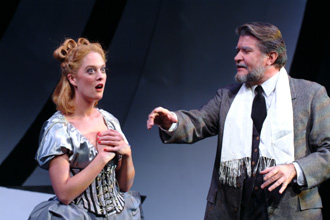SEARCH
REVIEWS
FEATURES
NEWS
Etcetera and
Short Term Listings
LISTINGS
Broadway
Off-Broadway
BOOKS and CDs
OTHER PLACES
Berkshires
London
LA/San Diego
Philadelphia
Elsewhere
QUOTES
On TKTS
LETTERS TO EDITOR
FILM
LINKS
MISCELLANEOUS
Free Updates
Masthead
Writing for us
A CurtainUp Review
Shakespeare in Hollywood

Polly Lee as Lydia and Bernard Burak Sheredy as Max Reinhardt
(Photo: Jim Roese) |
Magically appearing in Jack Warner's office, Oberon and Puck are cast in Warner Brothers 1935 movie, A Midsummer Night's Dream, directed by Max Reinhardt. When Oberon meets fair Olivia, who is auditioning for the part of Hermia, he orders Puck to put her under the spell of the magic flower, which will make her sleep and then fall in love with the first person she sees upon awakening. Unlikely combinations result as other characters accidentally become bewitched and end up falling for each other. Some fall for Daryl. (Who's Daryl?) Movie stars and random lines from Shakespeare plays are thrown into the mix along with affairs of the heart and wallet.
This certainly is fun, but there are problems: It has a slow start, and in the hubbub later, something is lacking. There's a disconnect. Perhaps the madcap elements could be wackier, or the exposition (which could be dropped) needs retooling. Certainly the important Oberon-Olivia connection needs time to percolate. The set, a huge, bold maze resembling a camera lens, dominates the stage and the action. It may be that all of these things unhinge parts of the play from each other and in the end distance the audience.
Veteran production designer Robert Pyzocha wanted to "define the Hollywood studio stages in a more poetic realm." Consistent with Max Reinhardt's concept of imaginativeness, the set is not realism-bound. Its practical design allows fluid entrances and exits and provides different levels, which work well, but it has big downsides: Brief projections are hard to discern, submerged in the strong black and white design of the maze. Even Jerold Forsyth's lighting can't alleviate its constant in-your-face presence. Most importantly, although the set works with Oberon's thunderbolts, it needs a lighter touch to not suppress any fleeting magic strands that may be in the air.
Referred to as a screwball comedy in program literature, this actually lacks the trademark central male-female battle of equally matched wits. Instead, at its best moments it has the feel of a bright and brisk backstage movie, the result of a happy combination of sharp dialogue, and good casting. The fabulous acting works at ensemble level and also at star-impression level.
Each actor's performance is fresh and rich in detail, from Marcia Saunders' Louella Parsons, "Hobnobbing with the vile and the vicious; it's like a dream come true!" to delightfully tawdry Lydia, girlfriend to a harrumphing Jack Warner. Lydia Lansing (Polly Lee) and Warner (John O'Creagh) are a funny and stereotypical bimbo/mogul Hollywood couple. Bernard Burak Sheredy's handsome Max Reinhardt character has a funky, extravagant accent. Chris Faith's tough little Cagney and Kevin Bergen's slightly dazed Dick Powell, along with Mike Dees' Joe E. Brown lend laughs. Christian Davidock as Warner's yes-man Daryl is suitably nerdy, and James Judy as the Narcissistic heavy, Will Hays, is an absolute marvel. Lanie MacEwan (Olivia Darnell), while perfect for the part, is a lead actress in need of more of a role. Caroline Tamas, whom we saw in Outrage at the Wilma last year, is an excellent sprightly Puck. Michael Sharon, whose Oberon role is a bit stiff, grows on you.
The show is enriched by Janus Stefanowicz's picture perfect costumes, from Olivia's Hollywood Shakespearean Bo Peep looking get-up, to the "real" fairy suits of Oberon and Puck. At times costumes and design meld, providing fine visual moments -- the four Warner Brothers in suits and hats talking on oversized phones, and views of sleek, elegant dancing at a party at Jack Warner's place.
Unfortunately, a good deal of exposition, supplied in bits throughout the show by Oberon, Puck, Warner, Reinhart and others, is clunky and tends to bog down the action. Director Jiri Zizka, who long ago mastered the mechanics of people moving (after the first quarter of an hour, and in between backstory, this play moves), seems to be taking this comedy very seriously. His actors are on board, but the writer's expository construct and the directorial vision reflected in the overwhelming design concept are problematic.
The sweet and lovely closing, which is surprising after the rumpus that has come before it, is less affecting than it might have been. And of course, the ending would be more lyrical if the overpowering set, which shouts "metaphor," an idea better whispered, were softened, scrimmed, or completely dimmed. By the end, one all but expects to see Warner Brothers' Porky Pig in the bulls-eye saying, "Th... Th... That's all folks,""but that's silly and not what this set is about.
|
Shakespeare in Hollywood
by Ken Ludwig Directed by Jiri Zizka, Artistic Director Cast: Kevin Bergen, Christian Davidock, Mike Dees, Chris Faith, James Judy, Polly Lee, Lanie MacEwan, John O'Creagh, Marcia Saunders, Michael Sharon, Bernard Burak Sheredy, Caroline Tamas Set Design: Robert Pyzocha Costume Design: Janus Stefanowicz Lighting Design: Jerold R. Forsyth Sound Design: Bill Moriarty At the Wilma Theater, Avenue of the Arts Running time 1 hour and 50 mins with one 15 min intermission 11/23/2005-12/31/2005; opening 11/30/2005 Reviewed by Kathryn Osenlund based on 12/07 performance |

Leonard Maltin's 2006 Movie Guide

Leonard Maltin's Classic Movie Guide

>6, 500 Comparative Phrases including 800 Shakespearean Metaphors by our editor.
Click image to buy.
Go here for details and larger image.




